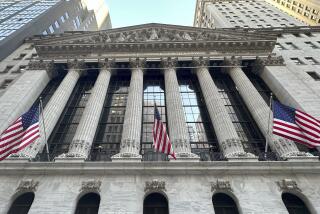Recent Price Increases Stir Familiar Fear--Inflation
A familiar fear was rising in the world’s financial markets Monday as stock prices hurtled downward--that inflation has crept back into the U.S. economy. The evidence includes recent surges in prices for consumer goods, raw materials, farm products and precious metals.
In addition, the sinking value of the dollar signals higher costs for imported goods, increases that will make it easier for U.S. manufacturers to follow with price hikes of their own.
“There’s a bigger shot of inflation from the lower dollar than most people think,” said Allen Sinai, chief economist for the New York investment firm Shearson Lehman Bros. “The financial markets are concerned, and the figures on prices provide justification for that concern.”
Few experts foresee anything approaching the double-digit inflation levels suffered in the late 1970s and early 1980s. But even a modest rise from the current 3.5% to 5% annual rate could cause difficulties for an economy that is expected to slow down next year. Inflation undermines the value of fixed-rate bonds, for example, and pushes up interest rates, making it costlier for people to borrow money.
“We have an unusual situation where you can have weak economic growth and still have relatively high inflation,” Sinai added in a telephone interview Monday. “That was certainly one of the ingredients in today’s big stock sell-off.”
Indeed, jitters about inflation would ordinarily not be expected in the wake of a stock market plunge that most analysts maintain has heightened risks of a recession. But the drooping dollar is providing strong upward pressure on prices and interest rates. Foreigners, for example, demand higher U.S. interest rates in order to protect their dollar-denominated securities.
A further 10% decline in the dollar could add more than two points to the inflation rate, economists say. Many analysts predict the dollar will fall at least that much over the next two years.
Yet while the battered dollar is of greatest concern to investors, many also cite recent price jumps of such commodities as copper, aluminum, lead and plastic resins as a sign that inflation is re-emerging.
Sharp Increases
For instance, the price that companies pay for copper has leaped from 66 cents a pound in early 1987 to a current level of $1 to $1.15. Similarly, aluminum prices have risen from 59 cents a pound earlier in the year to about 81 cents a pound, according to the WEFA Group, economic consultants in Bala Cynwyd, Pa.
Demand for such materials, which are used in machinery and construction, has increased as the dollar has fallen and made U.S. manufacturing more competitive. Expected future drops in the dollar are likely to further boost demand--and prices--as supplies stay tight.
“The bottom line is that sooner or later over the next several months, the cost buildup for these products will start showing up in higher (consumer) prices,” said Frantz R. Price, director of strategic industry analysis for WEFA.
The recent trend toward higher prices has been unexpectedly broad. As the stock market and dollar tumbled Monday, the Agriculture Department reported an unusual 3.1% November rise in farm commodity prices propelled by hikes for fresh fruits and vegetables. The report was an about-face from a drop of 1.6% the previous month. Gold, a barometer of inflationary expectations, is trading at levels approaching 25% higher than a year ago.
Broad-Based Movement
Earlier in November, the Labor Department reported that consumer prices in October rose 0.4%, an undramatic increase yet one that sparked new worries because it reflected an unusually broad-based movement toward higher prices.
For all the worrisome news, however, many analysts contend that investors are overreacting. There is little evidence, for example, of an acceleration in wage gains--a chief factor in the unnerving wage-price spirals of past years. In addition, it is not clear just how much the rise in certain commodities will be felt in consumer prices.
“In all fairness, there is an acceleration of inflation,” said Duane A. Paul, an economist with the Bank of America in Los Angeles. “But it’s still a far cry from 8% or 10%. We’re still a far cry from where we were in 1980 or ’81.”
What to Worry About?
Indeed, the anxiety-ridden financial markets seem uncertain whether to worry more about an economic chill ushered in by the stock market plunge or an overheating of prices and interest rates sparked by the lower dollar.
Although the falling dollar allows for some combination of the two, few expect a dire scenario of deep recession and rampant inflation.
David Wyss, an economist with Data Resources Inc., a Lexington, Mass., consulting firm, said concerns in the market have been boomeranging between inflation and recession, but he added: “You’re not going to get both.”
More to Read
Inside the business of entertainment
The Wide Shot brings you news, analysis and insights on everything from streaming wars to production — and what it all means for the future.
You may occasionally receive promotional content from the Los Angeles Times.










